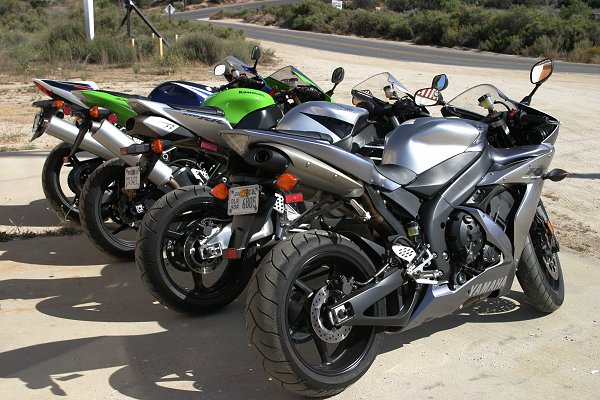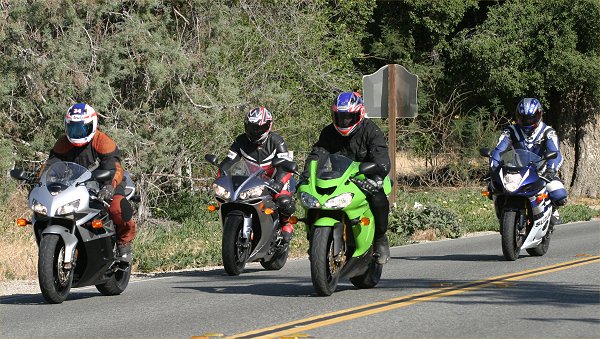
We have to start this story with some perspective for the reader. Perspective is always important when reading someone’s opinion about a product, of course, but it is critical when reading this comparison between the four motorcycles recently tested by MD.
Let’s start by pointing out that Suzuki’s GSX-R1000 has received accolades throughout the world from the motorcycling press over the past few years — clearly acknowledged as the top dog in the open-class sport bike category. Indeed, the GSX-R1000 was named the top motorcycle in the world by a group of publications (that included Cycle World here in the United States) in its latest iteration. The GSX-R1000 is a fantastic motorcycle. It finishes last in this comparison test. Not by much.
When motorcycle manufacturers decide which category of motorcycle deserves the highest number of development dollars (R&D dollars), they obviously look at sales volume and profits. The cruiser category is number one here in the United States, but sport bikes are not far behind. Sport bikes sell in large numbers, and therefore feed the bottom line of major manufacturers in a significant way, while also serving as a very important corporate image builder (corporate “flagship”, if you will). This is why Honda, Kawasaki, and Yamaha all responded with entirely new open-class sport bikes for 2004, bikes that arguably (an important qualifier) surpass the incredibly high standards set by the Suzuki GSX-R1000.
But what are these bikes good at? If the Suzuki GSX-R1000 is already gross overkill in the acceleration, top speed, braking and handling categories for the average street rider, does the average rider, or even a good rider, need something “better”? Or, does it just come down to a matter of styling preference and dealer convenience (“Joe’s Motorcycles is closest to me, they sell Brand X, and therefore I’m buying Brand X.”)? These are good, and legitimate, questions. Questions we will try to answer for you, but questions that nevertheless will linger regardless of what anybody says about these four exceptional machines.
Fortunately, we have already given you the technical details about each of our competitors, including the Honda CBR1000RR here, the Yamaha R1 here, the Kawasaki ZX-10R here, and the Suzuki GSX-R1000 here (a test of the 2003 model — essentially unchanged for 2004, except in minor respects). We can focus now on riding these motorcycles.
You can ride these motorcycles in essentially two places, on the track and on the street. We could have tested these motorcycles on the track (and we have no objection to doing so), but several other publications have already done this. Primarily, these other publications placed an extremely competent track rider (typically, a racer turned journalist) on these motorcycles, and set fastest lap times. You then read the results, and draw your own conclusions (“Gee, if I could ride like Sam Fastguy, I could lap Willow Springs 0.7 seconds quicker on Brand X than on Brand Y.”). This information is useful when it comes to determining the 10/10ths capabilities of these motorcycles, don’t get us wrong, but we chose to focus on street riding.
We did choose extremely good riders to test these motorcycles on the street. Three of our four testers are expert-level road racers. More importantly, they are extremely experienced as street riders, and ride motorcycles on the street all the time (something that is not true of many road racers — some of them hate riding on the street, and do not do it).
So our testers operate at an extremely high skill level, with yours truly excepted (I won’t pass judgment on my own skills, except to say they are somewhat less than the other three testers involved). If their skill level skews the results somewhat, so be it. You shouldn’t be shopping for one of these four motorcycles unless your own skill level is pretty high (not necessarily as high as some of our testers), and you will find their opinions varied nonetheless. There is no consensus here.
We will give you an overall ranking of the four machines below, but pay close attention to the individual rider’s opinions at the end of this article. Three of the four bikes received a first place vote from at least one rider.
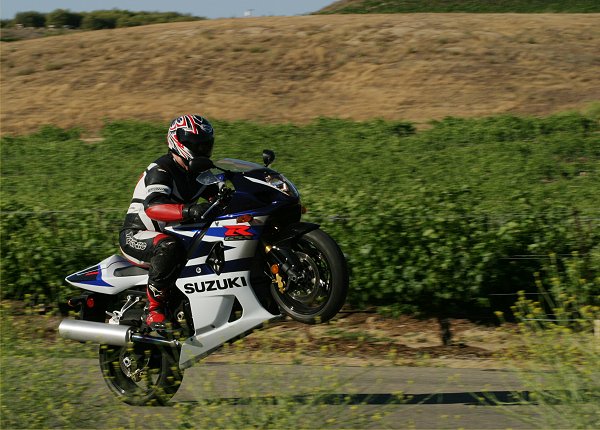
Suzuki GSX-R1000 (Fourth Place)

Like most journalists, we have raved about this motorcycle since it was first introduced several years ago. The latest version of this bike (introduced as a 2003 model) is a real gem. It is the same bike for 2004, with one notable difference in this test. The performance of the front brake, in our opinion, took a step backwards. The only thing we can point to is the change made by Suzuki between the 2003 and 2004 model years, involving the front brake pads. Rather than the four-pad-per-caliper configuration used in 2003 (one pad per piston), Suzuki switched to two pads per caliper for ’04. The result is less bite, less power and less feel. The 2004 Suzuki GSX-R1000 still has good brakes, mind you, but they don’t measure up in this company.
The rest of the package is still top drawer. The engine is mega-powerful, with its characteristic low-end and mid-range untouched. This bike has plenty of power where it needs it on the street, and will hang with the other bikes (or pull away from them) in top gear roll-ons. Still, next to the newer designs from the other manufacturers, the GSX-R1000 is starting to feel big and heavy. It is all a matter of degree, of course, but that is what comparisons are all about, anyway. Big means comfortable in this instance, which is a good thing for the street. Ergonomics and wind protection are pretty good on the Suzuki, as is the seat and the suspension compliance. Suzuki smoothed out the power delivery of the GSX-R1000 last year, but the bike still revs a bit too eagerly down low. It has more of a “hit” than the other bikes, and feels somewhat “raw” in this company, but is still easy enough to control on the street. In fact, that low-end “hit” can be fun on corner exits, just make sure your tires are warm and you have plenty of traction.
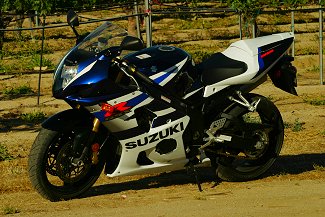
Instrumentation and controls are fine, although instrumentation has dropped a tad behind both the Yamaha and the Honda (the Kawasaki has an illegible tachometer — more about that later).
In the end, the Suzuki is still an excellent motorcycle. It took exceptional efforts by the other manufacturers to bring some of its shortcomings to light, and put it in last place in our comparison testing.
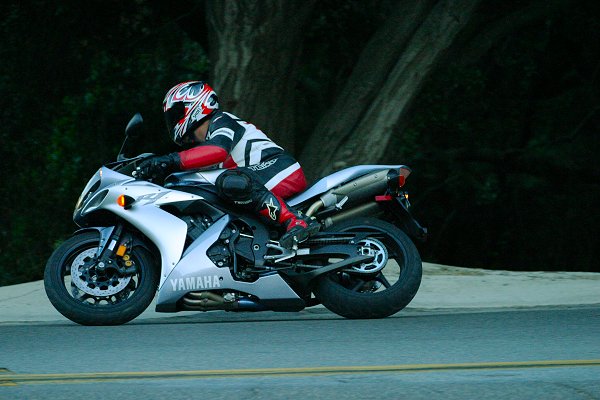
Yamaha R1 (Tied for Second Place)
The 2004 Yamaha YZF-R1 received a first place vote from one of our testers, and ties for second overall. The 2004 R1 is a very refined, and integrated design. The styling was considered best by most of our testers (and most observers, in general).
Our testers also liked the R1’s suspension. Indeed, it is hard to criticize the Yamaha chassis. The suspension is controlled, but reasonably comfortable on the street, while the brakes are excellent (but both Kawasaki and Honda have great brakes on their open classers, as well). Handing was neutral and confidence inspiring, and feedback through the tires (both the front and the year) is commendable, if not the best in the class.

The Yamaha falls short in one significant area, however. Although the bike makes plenty of peak horsepower (right up there with the best in the group), it does so at a higher level on the tachometer. Yamaha gave the YZF-R1 the highest redline of any bike ever manufactured for street use at this displacement level (13,750 rpm). Indeed, this redline would have been notable in a 600 just a few years ago. As a result, this motor has huge tuning potential, and, as stated, very competitive peak horsepower in stock trim. It is a powerband somewhat like a “600 on steroids”, however. Coupled with very tall gearing (particularly, in first gear), the R1 gets left behind in roll-ons against the competition at typical street rpm levels.
Don’t get us wrong. The R1 always feels powerful, and has plenty of low-end torque and mid-range when compared with “normal” motorcycles. Like the Honda, it very nearly won this comparison test. Forced to pick nits, however, the powerband of the R1 (coupled with the tall gearing) is a nit that gets picked.

As we mentioned in our initial ride report, there is heat felt on the rider’s butt, particularly at sustained high rpm running. We tested in mild temperatures, so we can’t report whether this would become annoying on hot days or not. It was noticeable, but not significantly annoying during our test (some of our riders didn’t even notice it). The underseat exhaust is the source of this heat, of course, and we wouldn’t be surprised to see an updated heat shield available for purchase and rather simple installation.
If the styling of the R1 knocks you out, you are not alone. Yamaha paid plenty of attention to styling, knowing that purchase decisions are frequently swayed by this element. The overall quality of the R1 package means you won’t be sorry if you buy the R1 for its looks.
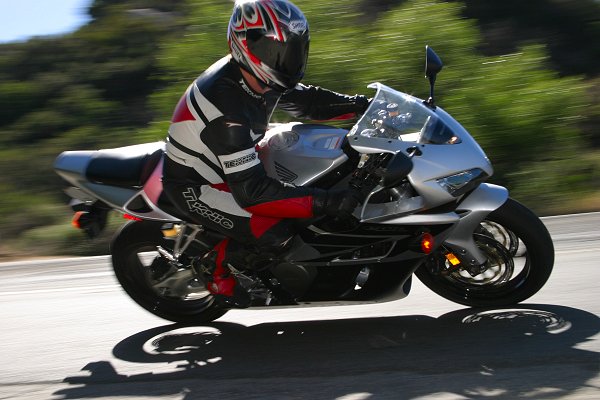
Honda CBR1000RR (Tied for Second Place)
You knew Honda was working on an all-new engine for its open-class machine when it continually bored and stroked its old open-classer (first arriving at 929cc, and ultimately, at 954cc). The motor in the CBR1000RR is not only new, it is truly a great street engine. With the longest stroke in this group, the CBR is about torque. Torque delivered smoothly and seamlessly. Torque that allows the 1000RR to pull hard at the rpm levels average street riders will be using day-in and day-out.

The Honda shrieks on top, as well, but not like the R1 or the ZX-10R. It gives a little bit away on top, but this is a trade well worth making for most street riders, and one that will be virtually unnoticed by many.
Some of the riders felt that the 1000RR was a bit buzzy. Nothing annoying, thank goodness, and simply reflecting the refined nature of all of these machines in this category. All of these motors tend to be smooth, and low on vibration, but stepping off the Yamaha, for instance, and onto the Honda, made the rider take notice.
The Honda also handles extremely well on the street. More than one rider mentioned that he was immediately comfortable on the Honda (something we have heard about plenty of Hondas in the past). The ergonomics are very good and neutral feeling. Somehow, Honda seems to relate the bars, pegs and seat in a way that short riders and tall riders all find pleasing. They have done so with the 1000RR.
The brakes on the Honda might just be the best in this category (and that is saying a lot, trust us). Excellent initial bite, great power, and great feedback reflect Honda’s choice to go with radial mounted calipers gripping the largest front discs in this group.

Ride hard in the twisties, and the Honda feels balanced, and the trick, electronic steering damper does its job well. Suspension settings are a bit soft, however, and faster and/or heavier riders will be looking for stiffer springs to put in the Honda’s fork. Indeed, the CBR1000RR felt great until ridden back-to-back by two of our testers with Yamaha’s R1 in an extremely tight, twistie canyon. The Yamaha felt just right, while the Honda clearly felt too soft and, indeed, a bit flustered.
Nevertheless, as a package, the Honda will not disappoint. One of our testers (one of those experienced road racers) picked the CBR1000RR as his favorite bike. This rider was the lightest in our group (roughly 150 pounds), and he did not take issue with the suspension.
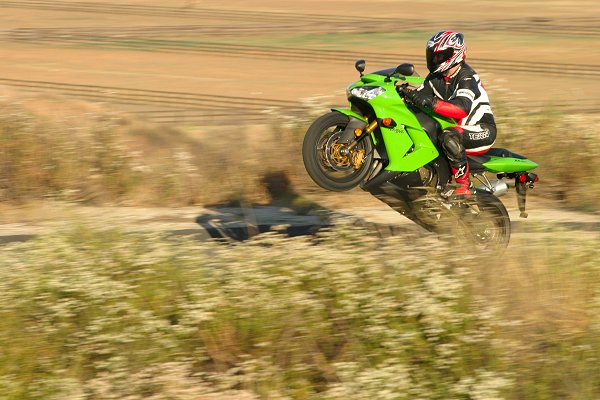
Kawasaki ZX-10R (First Place)
Two of our testers chose the Kawasaki ZX-10R as their favorite bike (including yours truly). For one of those testers (again, yours truly), it was a very close choice between the ZX-10R and the Yamaha R1. For the other tester, the ZX-10R just nosed out Honda’s CBR1000RR. It was that close.
At the same time, we have no qualms about labeling Kawasaki’s ZX-10R the ultimate open-class sport bike. This is the highest performance motorcycle ever available to the general public. In terms of performance, the ZX-10R doesn’t do everything well, it does everything brilliantly, and, indeed, sets new standards.

Beginning with the engine, the ZX-10R combines the greatest peak power with the broadest spread, and one of the smoothest, most linear deliveries in this group. Despite a first gear nearly as tall as the Yamaha R1’s, the Kawasaki refused to lose any of our roll-on contests (with the Honda hanging right with it, up to a point, where the ZX-10R would walk away rather briskly). This bike delivers you from corner to corner quicker than any other, and quicker than you are ready for (at least, until you re-calibrate your mind to deal with it).
The Kawasaki also has great brakes (it really needs great brakes). Depending on who you ask, they are either the best in this class, or darn close. Despite relatively small discs, Kawasaki has engineered an extremely stiff caliper and pad combination that provides excellent feel and power. The ZX-10R doesn’t have the initial bite of the Honda’s front binders, but its ultimate power and feedback is in the same class.

With the shortest wheelbase and the lightest weight, it is probably not surprising that the ZX-10R comes closest to achieving the holy grail of open-class handling (i.e., the feel of a 600).
This bike changes directions, accelerates and stops like an extremely small, light machine. It is these things, of course, and the engineering feat most remarkable is that the bike is not nervous despite the coupling of its tiny dimensions with the monster engine of the class.
Some publications have referred to the ZX-10R as nervous, or prone to headshake. We emphatically disagree. The ZX-10R is neither nervous, nor prone to headshake (despite the lack of a steering damper). What it is, is “immediate”. The ZX-10R does exactly what you ask it to do, and it does it right now. There is no slack in this machine’s handling. In this regard, it feels just like a race bike.
The tachometer on our ZX-10R is essentially useless. This is the single biggest flaw on this bike, but it is easily outweighed by its virtues.

The last time I rode the ZX-10R during our test, I came to a stop at a red light, laughed out loud in my helmet and shook my head. The analogy in my mind was a video game. A video game where you can ride a motorcycle and make it do crazy things. Wheelies, stoppies and burn outs. You almost feel like you could do a pirouette. But you could also trundle along slowly and comfortably, obeying the laws of man and nature. The 2004 Kawasaki ZX-10R makes you feel like you are capable of all these things, but you are in the real world on a real motorcycle. Simply amazing.
Not all of our testers agreed that the ZX-10R should win this comparison test. In the end, however, the only important thing the ZX-10R lacks is the ability to suffer fools. You need to be alert, and paying attention when you ride this motorcycle. It’s immediacy is wonderful when you are in the mood for it. It can be annoying when you are not.
So, each of you can draw your own conclusions (as our four experienced testers did) about these four bikes. Our aim was to give you information helpful in doing that. I hope we accomplished this. Take a close look at our tester’s individual rankings and comments below. If you buy any one of these motorcycles, treat it with the utmost respect, and you will experience a level of performance that street motorcyclists could only dream of just a few years ago.
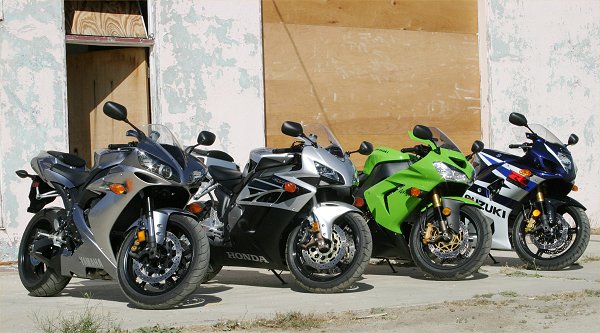
Willy Ivins
Oh boy, my head has been spinning! What a stunning group of motorcycles these machines are! There is something here for everyone. In a street environment, all these bikes are overkill of the highest order, but it is where a vast majority will live out their lives and so we tested them in this environment. Truly, you can buy any of these machines based on whatever criteria you deem suitable and ride away on the winner. Because of this, I can’t say which one is best for you, but I can say which one is best for me and why, so here is my list, in specific order.
1st – Kawasaki. This bike is the one that has best fulfilled all of the performance parameters that the competitors of this class have boasted about through the last several years. Lightest in class, and lighter than some 600s, it exhibits true, 600-class handling that’s stable, too, despite the lack of a steering damper. Compact, but comfortable ergonomics keep the rider off the chiropractor’s Christmas card list, while high quality suspension provides a firm, but not jarring ride. The king-kong engine keeps all comers at greater than arm’s length in “all” situations, despite the tall gearing. The brakes could stop the space shuttle short on a carrier landing, with all the control and feel you could wish for. Gearbox issues experienced during the intro are nowhere to be found on the production model. The instrument cluster still sucks, though. This bike is a shot of adrenaline straight to the heart. I could go on and on, but there isn’t room…. I’ll take one in blue, please.
2nd – Honda. It took a little while for me to warm up to the Honda. It’s not in-your-face about performance, it just goes about its business in a quiet, but inevitable manner. It’s sneaky fast, like the butler in the movie Mr. Deeds. My time aboard it made me realize that while it doesn’t have the brute power of the ZX or YZF, it does have gearbox ratios and midrange power to keep the Kawi in sight and (up to a point) the YZF in its mirrors. Its chassis isn’t as nimble as the Kawasaki’s or Yamaha’s, but it is reassuring and confidence inspiring, with brakes that nearly equal the class leader. It’s only let down for me is the suspension. I, and most of you I bet, modify the bike’s suspenders to suit, a relatively easy and inexpensive solution (compared to rearranging an engine’s powerband) that would put this bike a step closer to equaling the Kawasaki’s street competence.
3rd – Yamaha. I thought, as many did, that this bike would knock all comers flat on their backs. Super model looks, huge horsepower bolted into an all-new chassis, excellent fit and finish, etc. Indeed, the YZF’s chassis and suspension combine to give the rider aboard the most feedback and confidence of the group, and you don’t need to have years of track experience to enjoy this handling bliss. The brakes were great, but didn’t measure up when run alongside the Kawasaki and Honda anchors. The engine, while hugely powerful at its peak, feels a little flat below 7000 due to a track-oriented set of gearbox ratios and a top-heavy powerband. Gear for gear against the Honda and Suzuki, which have street oriented transmission ratios, the Yamaha was repeatedly playing catch up during roll-on acceleration that got worse the higher you rose in the ratio selection. Ridden in isolation, or strictly in the meat of the power, you may never come to realize this, but I infrequently see sport bikes ridden out of a group, or (in the liter class) revving above 7K rpm all time. Heat from the underseat exhaust was bothersome, as well.
4th – Suzuki. Once top of the heap, it now is an also-ran. It never did anything wrong or badly, it just always seemed two steps (or three behind the ZX) behind the freshly updated warriors of the class. In comparison, the chassis feels long and slightly lazy, and the suspension felt a little untidy. The quick-revving, torque-laden engine kept the bike in the hunt, but never up front. Brakes, once as lethal as the engine, have been toned down considerably. The initial bite, feel and overall power lag behind the others. Ergonomics felt rangy, with a longish reach to the bars. The seat felt quite cushy compared to the Honda’s.
What a privilege it has been to swing a leg over what is the current pinnacle of motorcycle performance. Without a doubt, these machines are the ultimate arm-stretching, eyeball-flattening devices of velocity and kinetic energy – for this year, anyway. It’s difficult to imagine how, but they always get better each year. As with any motorcycle, but these especially, skill, maturity and respect must all be present in massive quantities to fully access / appreciate their capabilities and to use those capabilities in a responsible, appropriate manner. Enjoy, but be careful out there.
Jeff Whitmer
4th place – The Suzuki GSX-R1000
* good chassis
* great brakes
* a little down on power here
* styling becoming dated
* very comfortableThe GSXR is starting to show it’s age when mixed with this crowd. By no means is the Suzuki a bad bike, when ridden back to back with the others, it just feels a little slower and a little heavier.
3rd place – The Kawasaki ZX-10RR
* excellent chassis
* excellent brakes
* the engine makes massive power but it feels slow (like a heavy flywheel)
* the styling is nice, but only nice
*definitely a racy seating positionThe Kawasaki felt the most like a race bike when riding it. The engine makes incredible power but still feels a little slow.
2nd place – The Honda CBR1000RR
* excellent chassis, although a little softly sprung
* very, very good brakes
* a well balanced engine package, nice grunt, revs quickly, feels fast
*excellent styling, the only complaint is the matte finish lower fairing
* a relaxed seating position, a little heat felt from the under seat exhaustThe Honda is an excellent package, it just lacks the suspension of the Yamaha. The engine is the most user friendly of the bunch
1st place – The Yamaha YZF-R1
*awesome chassis
* great brakes
* missing a little grunt but it makes up for it on top
* gorgeous styling, almost European looking
* not a bad seating position, the seat gets a little hot from the under seat exhaustThis is the bike that made me giggle the entire time I rode it. With the soft power at the bottom of the rev range you have to ride it like a 750 or 600 and keep the rpm’s up. The chassis is near flawless with excellent ride quality and stability.
Quentin Wilson
Honda – The Machete. I would purchase this bike for street/track day duty above the others. Heavy and down on top end, but easiest to ride hard and most comfortable to go fast on. Two words: Confidence Inspiring. Great front-end feel and fantastic brakes make for superior corner entries and supple mid-corner feel. I could also make mistakes, having to adjust my line mid-corner, changing lean angles and throttle position, without the bike getting upset. The power was nearly perfect, enough to get into serious trouble and to have lots of fun, but not so much that the bike feels as if it will wheelie at the slightest provocation. Corner exits are a snap, just pick the line and twist on the throttle and the great gear ratios and superior engine feel toss you to the next corner or down the next straightaway. The dash and controls were superior to the my next pic, the Kawasaki, as was the fit and finish. I suggest that this is the most handsome of the four, especially fantastic from the rear 3/4 view.
Kawasaki – The Razor Blade. I would purchase this bike for race/track day duties above all others. The engine is magic, pure smooth power and linear torque make it easy to modulate. So fast that it is scary in every gear, but relatively controllable especially in reference to the Yamaha. The chassis is the smallest and lightest feeling, but the engine revs slower and feels like it has a lot of mass, which makes a nice balance. The brakes are on par with the Honda with not quite as much feel. It changes direction very easily, but does not reward sloppy riding or mistakes. The slipper clutch is worth its weight in gold, allowing deep corner entries. This bike makes you feel as if you are Shinya Nakano on the Kawi MotoGP bike. And it looks the part, very fantastic styling. The dash is really bad, hard to read and poorly laid out. A nice Motec digital dash sitting on a race fairing bracket would take care of that. This bike nips at the heels of the Honda on the street but would smoke it on the track, of this I am certain.
Yamaha – The Steak Knife. I would not purchase this bike with the Honda and Kawasaki available. The gear ratios, clutch, and powerband are awful. The engine does not make good power low enough in the rev range, and the gear ratios are such that street riding becomes a pain in the ass. The clutch felt weak, the brakes were merely adequate and the seat got extremely hot. The chassis is good, feeling much like the Honda in corner entry and mid corner, but exiting the corner was hard due to the poor gearing and engine character. The fit and finish was ok, the dash was ok, and the seating position was ok. Once on boil this bike is extremely fast but that is of little consequence if the Kawasaki has already accelerated to top speed while you are waiting for this bike to boil up.
Suzuki – The Box Cutter. As strange as it sounds, this bike needs an update. It will have to be much closer to the new-for-2004 GSX-R750’s stature to come close to the other machines on the street. The power is good, but not linear, spiking early, then running out of breath, then screaming at the top end. The engine is not as useful as the Honda or the Kawasaki. The seating position and cockpit are ready for a trip from LA to NY. I would pick this bike to super-tour on. The side mounted exhaust allows storage space under the seat, which is missing from the Honda and Yamaha. The fit and finish, and general layout are not refined, not even as much as the 750. The chassis did not do anything I wanted it to do, whereas the 750 does it all. If the 2004 Suzuki GSX-R750 were in this test I would have picked it as 3rd (behind the Kawasaki).
Dirck Edge
For me, the Kawasaki ZX-10R represents the high water mark in sport bike design. Aside from the horrible tachometer, there is little I can criticize about the Kawasaki. Is it the right bike for everyone? No. This is the ultimate “race bike with lights”, demanding, perhaps, greater skill and precision than the others to be ridden near its limits. If you are not comfortable with the front wheel in the air, don’t buy the ZX-10R. If you have the skills, however, this bike rewards like no other.
The Yamaha R1 was a very close second for me. The handling is superb. It feels fluid and, for this group, is very easy to ride at a quick pace. The suspension is excellent, and the occasional warm butt really isn’t an issue for me. At least, in mild weather. It dropped a tick behind the Kawasaki ZX-10R due to its gearing (yeah, I know, a sprocket change could largely solve this) and top-end biased powerband.
When I tested the Honda with this group, I was probably able to adapt to it quickest. Ergonomically, everything is in the right place and the instrumentation is excellent. The motor is right there with the ZX-10R on the street due, in part, to better gearing. Ridden back-to-back with the R1, I agreed with another tester that the stock suspension was just too soft and underdamped. For a lighter rider (I weigh 210), the suspension might not be an issue, but both the Kawasaki and Yamaha suspension systems worked better for me. Also, you won’t find better brakes than those on this bike.
The Suzuki is last on my list, but not because it has any glaring faults. It feels a little bigger and less refined than the competition this year, and that ends up making the difference. The motor is relatively smooth and linear, but less so than the competition, and this is a very important factor when evaluating bikes this powerful. Also, Suzuki mysteriously took a step backwards from its awesome front brakes on the 2003 model. As with all these bikes, when you have this much “go”, you need plenty of controllable “whoa”.
